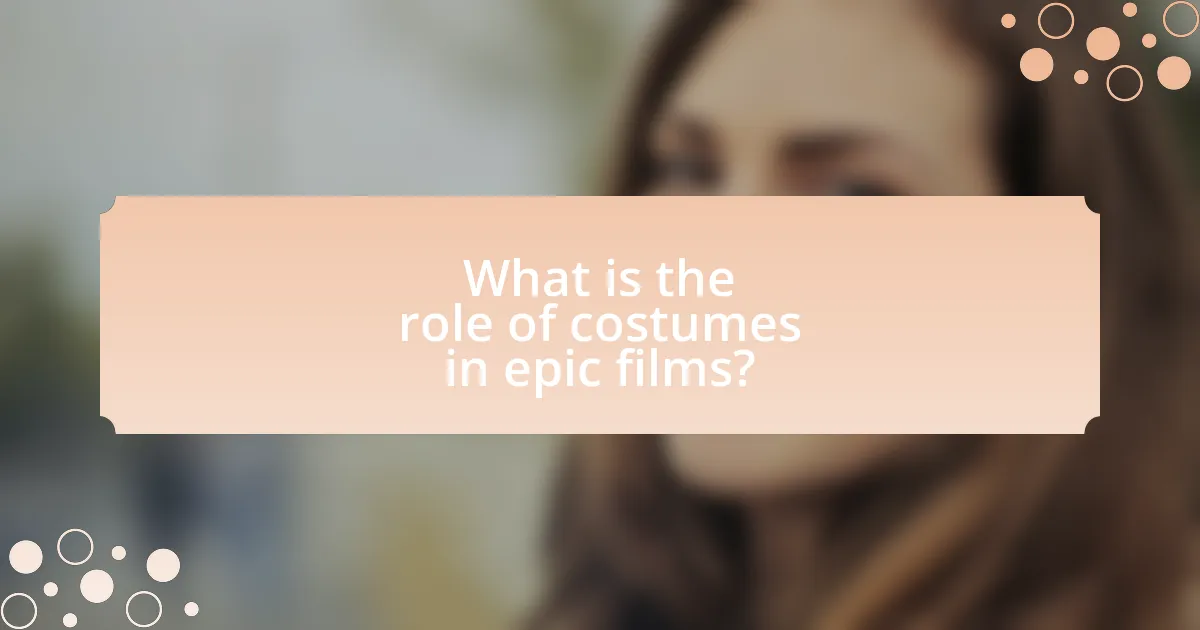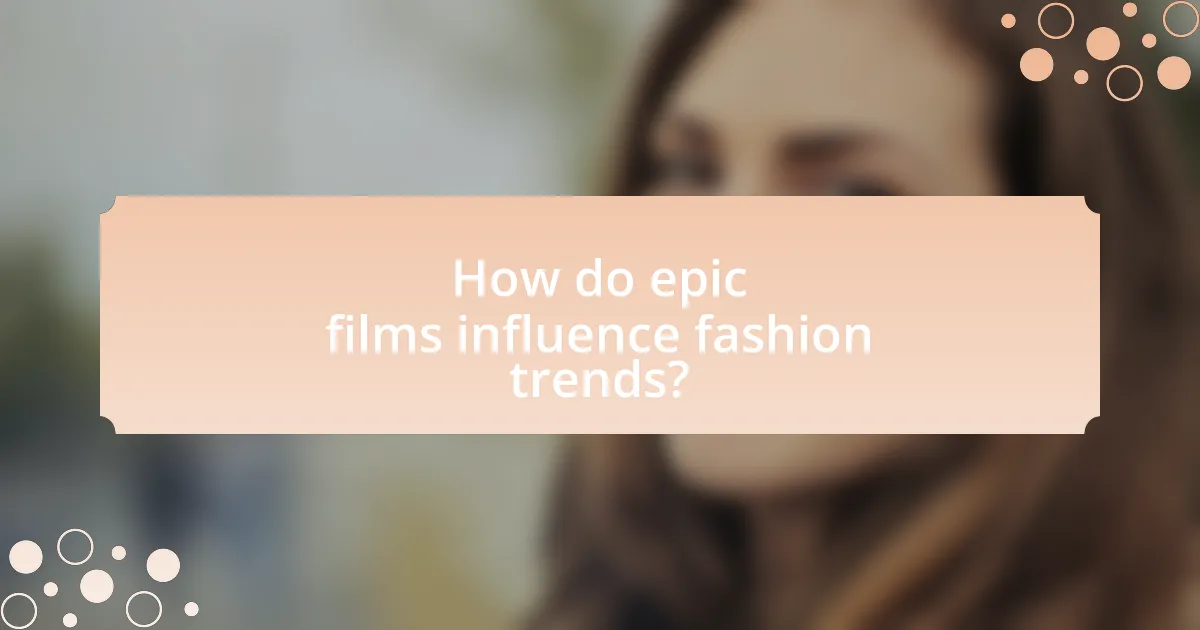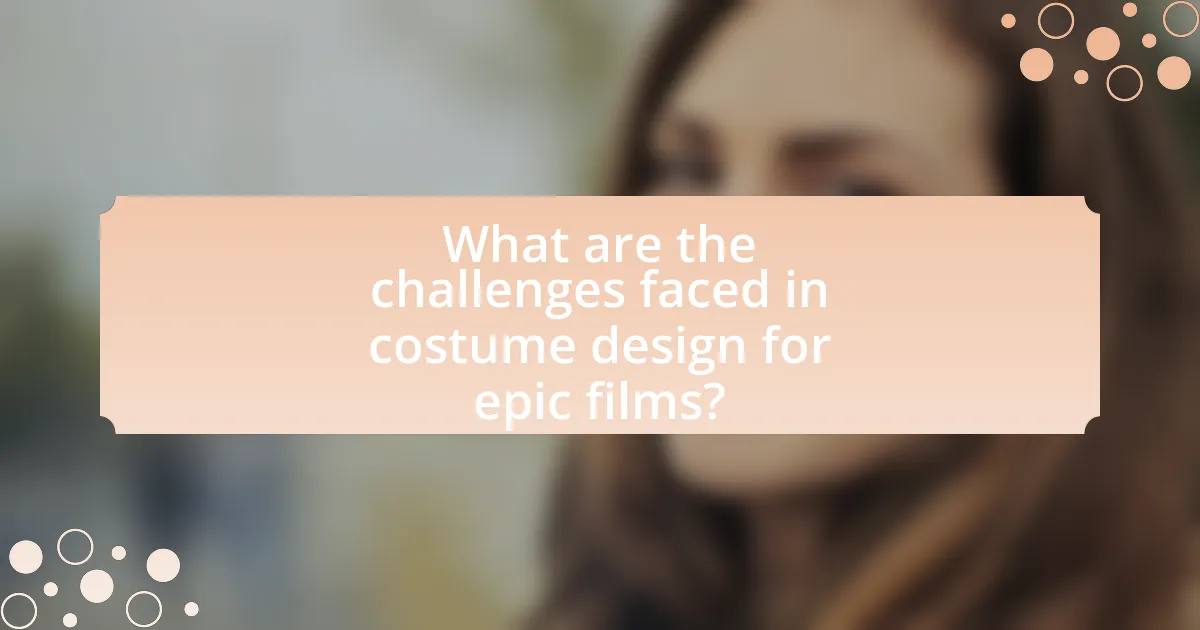The article explores the critical role of costumes in epic films, emphasizing their function in character identity, cultural context, and visual storytelling. It examines how costumes contribute to character development, signify evolution, and reflect personality traits through design elements such as color, fabric, and silhouette. Additionally, the piece highlights the intersection of high fashion and fantasy in costume design, detailing how designers blend innovative techniques with narrative needs while addressing challenges like budget constraints and production timelines. The influence of epic films on real-world fashion trends and the importance of collaboration between filmmakers and designers are also discussed, showcasing the impact of technology on modern costume fabrication.

What is the role of costumes in epic films?
Costumes in epic films serve to establish character identity, convey cultural context, and enhance the visual storytelling. They are meticulously designed to reflect the time period, social status, and personality traits of characters, thereby aiding audience immersion. For instance, in films like “The Lord of the Rings,” costumes are integral in differentiating between various races and cultures, such as the regal attire of elves versus the rugged clothing of hobbits. This differentiation not only supports narrative clarity but also enriches the film’s world-building, making it more believable and engaging for viewers.
How do costumes contribute to character development in epic films?
Costumes significantly contribute to character development in epic films by visually representing a character’s identity, status, and transformation throughout the narrative. For instance, in “The Lord of the Rings,” the evolution of Frodo’s costume from simple hobbit attire to a more rugged look symbolizes his journey from innocence to the burden of responsibility. This visual change not only reflects his internal struggles but also enhances audience understanding of his character arc. Additionally, costumes can signify alliances and conflicts; for example, the contrasting armor of different factions in “Game of Thrones” clearly delineates loyalties and power dynamics, further enriching character relationships and motivations.
What elements of costume design reflect a character’s personality?
Costume design elements such as color, fabric, silhouette, and accessories reflect a character’s personality. For instance, vibrant colors often signify a bold or extroverted personality, while muted tones may indicate introversion or somberness. The choice of fabric can convey social status or emotional state; luxurious materials like silk suggest wealth and sophistication, whereas rough textures may imply a rugged or rebellious nature. Silhouettes also play a crucial role; fitted designs can represent confidence and control, while loose, flowing garments may suggest freedom or a carefree attitude. Accessories, such as jewelry or weapons, further enhance character traits, indicating power, wealth, or personal history. These elements work together to create a visual narrative that aligns with the character’s role and development within the story.
How do costumes signify character evolution throughout the film?
Costumes signify character evolution throughout the film by visually representing changes in a character’s identity, status, and emotional journey. For instance, as characters undergo significant transformations, their costumes often shift in color, style, and complexity, reflecting their internal struggles and growth. A notable example is the transition from simple, muted clothing to elaborate, vibrant outfits, which can symbolize a character’s rise in confidence or power. This visual storytelling technique is supported by research indicating that costume design plays a crucial role in character development, enhancing audience understanding of the narrative arc and emotional depth.
Why are costumes considered a form of high fashion in epic films?
Costumes are considered a form of high fashion in epic films because they often embody intricate design, craftsmanship, and cultural significance that elevate them beyond mere clothing. These costumes are typically created by renowned designers who apply high fashion principles, utilizing luxurious materials and innovative techniques to enhance the visual storytelling of the film. For instance, the costumes in films like “The Lord of the Rings” and “Game of Thrones” not only serve to define characters but also reflect the historical and fantastical elements of the narrative, showcasing artistry that parallels runway fashion. The meticulous attention to detail and the collaboration with fashion houses further solidify their status as high fashion, as seen in the work of designers like Ngila Dickson and Michele Clapton, who have received accolades for their contributions to costume design in cinema.
What are the key characteristics that define high fashion in costume design?
High fashion in costume design is characterized by innovation, exclusivity, and artistic expression. Innovation manifests through the use of unconventional materials and cutting-edge techniques, often pushing the boundaries of traditional garment construction. Exclusivity is evident in the limited production runs and bespoke tailoring, which cater to a select clientele, enhancing the allure of the designs. Artistic expression is showcased through bold color palettes, intricate detailing, and thematic storytelling, allowing costumes to convey deeper narratives within the context of epic films. These characteristics are essential in distinguishing high fashion costumes from standard attire, as they elevate the visual experience and contribute significantly to the overall cinematic artistry.
How do designers blend high fashion with fantasy elements in costumes?
Designers blend high fashion with fantasy elements in costumes by incorporating avant-garde silhouettes, luxurious fabrics, and imaginative details that evoke otherworldly aesthetics. For instance, designers like Alexander McQueen and Jean Paul Gaultier have utilized exaggerated proportions and intricate embellishments to create garments that transcend traditional fashion norms, often drawing inspiration from mythology and folklore. This fusion is evident in films such as “Pan’s Labyrinth,” where costume designer Eugenio Caballero combined historical references with fantastical elements to enhance character narratives, demonstrating how high fashion can elevate the visual storytelling of fantasy genres.

How do epic films influence fashion trends?
Epic films influence fashion trends by showcasing elaborate costumes that often set new aesthetic standards in the fashion industry. For instance, films like “The Lord of the Rings” and “Game of Thrones” have introduced styles characterized by intricate detailing, rich fabrics, and historical references, which designers have subsequently adapted into contemporary collections. The impact is evident in runway shows where designers draw inspiration from these cinematic visuals, leading to a resurgence of specific styles, such as medieval-inspired garments or fantasy-themed accessories. This phenomenon is supported by the fact that fashion retailers frequently report increased sales of items reminiscent of popular film costumes, demonstrating a direct correlation between epic films and consumer fashion choices.
What impact do iconic costumes have on real-world fashion?
Iconic costumes significantly influence real-world fashion by inspiring designers and shaping trends. For instance, the costumes from films like “The Great Gatsby” and “Black Panther” have led to a resurgence of 1920s styles and African-inspired designs in contemporary fashion collections. Designers often reference these costumes in their runway shows, translating cinematic aesthetics into wearable art. The impact is evident in the way fashion weeks showcase pieces that echo the bold colors, intricate patterns, and unique silhouettes seen in iconic film costumes, demonstrating a direct correlation between cinematic visuals and fashion innovation.
Which epic films have set significant fashion trends?
Epic films that have set significant fashion trends include “Star Wars,” “The Lord of the Rings,” and “Pirates of the Caribbean.” “Star Wars” introduced iconic elements such as the Jedi robes and Princess Leia’s hairstyle, influencing sci-fi fashion and pop culture. “The Lord of the Rings” popularized medieval-inspired attire, with its detailed costumes sparking interest in fantasy-themed clothing. “Pirates of the Caribbean” revived interest in pirate aesthetics, showcasing elaborate costumes that led to a resurgence of interest in historical and fantasy fashion. These films not only shaped cinematic visuals but also left a lasting impact on fashion trends in broader culture.
How do designers draw inspiration from epic film costumes for their collections?
Designers draw inspiration from epic film costumes by analyzing the visual storytelling, character development, and thematic elements presented in these films. They study the intricate details, color palettes, and fabric choices used in costumes to evoke emotions and convey narratives. For example, the elaborate costumes in films like “The Lord of the Rings” or “Game of Thrones” often influence designers to incorporate similar textures and silhouettes into their collections, reflecting the grandeur and fantasy of these cinematic worlds. This practice is supported by the fact that many fashion collections have been directly inspired by the aesthetics of successful films, leading to collaborations between designers and film studios, such as the partnership between Gucci and the film “Gucci.”
Why is collaboration between fashion designers and filmmakers important?
Collaboration between fashion designers and filmmakers is important because it enhances the visual storytelling of films through innovative costume design. This partnership allows designers to create garments that not only reflect the characters’ personalities but also contribute to the overall aesthetic and thematic elements of the film. For instance, in films like “The Great Gatsby,” costume designer Catherine Martin worked closely with director Baz Luhrmann to create a visually stunning representation of the 1920s, which significantly influenced the film’s reception and cultural impact. Such collaborations result in costumes that are not only functional but also serve as a vital narrative device, enriching the audience’s experience and engagement with the story.
What are the benefits of integrating high fashion into film costume design?
Integrating high fashion into film costume design enhances visual storytelling and character development. High fashion brings unique aesthetics and innovative designs that can elevate the overall production value of a film. For instance, films like “The Great Gatsby” utilized high fashion to reflect the opulence of the era, contributing to the film’s critical acclaim and box office success. Additionally, high fashion can create memorable and iconic looks that resonate with audiences, as seen in “Black Panther,” where costumes designed by Ruth E. Carter combined traditional African elements with contemporary fashion, earning her an Academy Award. This integration not only enriches the narrative but also fosters a deeper connection between the audience and the characters.
How do collaborations enhance the visual storytelling of epic films?
Collaborations enhance the visual storytelling of epic films by integrating diverse artistic perspectives and expertise, which enriches the overall narrative and aesthetic. For instance, partnerships between directors, costume designers, and visual effects teams create a cohesive visual language that aligns with the film’s themes. A notable example is the collaboration between director Peter Jackson and costume designer Ngila Dickson in “The Lord of the Rings” trilogy, where their joint efforts resulted in iconic costumes that not only defined characters but also reflected the film’s epic scale and fantasy elements. This synergy allows for a more immersive experience, as each collaborator contributes unique insights that elevate the storytelling through visual elements.

What are the challenges faced in costume design for epic films?
Costume design for epic films faces several challenges, primarily due to the need for historical accuracy, budget constraints, and the integration of fantasy elements. Historical accuracy is crucial as designers must research and replicate clothing styles from specific time periods, which can be labor-intensive and require extensive resources. Budget constraints often limit the materials and techniques available, forcing designers to find creative solutions while maintaining quality. Additionally, integrating fantasy elements poses a challenge, as costumes must not only reflect the film’s world but also resonate with audiences, requiring a balance between imaginative design and practical wearability. These challenges are evident in productions like “The Lord of the Rings,” where the intricate designs required significant research and collaboration with artisans to achieve authenticity while staying within budget.
How do budget constraints affect costume design in epic films?
Budget constraints significantly limit the resources available for costume design in epic films. These financial limitations often result in reduced fabric quality, fewer costumes, and less elaborate designs, which can impact the overall visual storytelling. For instance, films like “The Lord of the Rings” had to prioritize certain costumes over others due to budgetary restrictions, leading to a focus on key characters while secondary ones received simpler attire. This approach can affect the authenticity and richness of the film’s world, as seen in productions where extensive costume details are essential for character development and setting immersion.
What strategies do designers use to create high-quality costumes on a budget?
Designers create high-quality costumes on a budget by utilizing techniques such as fabric sourcing, upcycling materials, and leveraging digital technology. By sourcing fabrics from discount suppliers or repurposing existing garments, designers can significantly reduce costs while maintaining quality. Upcycling involves transforming old costumes or textiles into new designs, which not only saves money but also promotes sustainability. Additionally, digital technology, such as 3D printing and computer-aided design, allows for precise and cost-effective production of intricate costume elements, reducing the need for expensive labor and materials. These strategies have been successfully employed in various productions, demonstrating that high-quality costumes can be achieved without excessive spending.
How do production timelines impact the costume design process?
Production timelines significantly impact the costume design process by dictating the schedule for design, fabrication, and fitting phases. A tight timeline can limit the designer’s ability to explore creative options, often necessitating quicker decisions and potentially compromising the quality of the costumes. For instance, in large-scale productions, such as epic films, the need for extensive costume changes and fittings can lead to a compressed schedule, which may result in less time for fabric selection and detailed craftsmanship. Historical examples, like the production of “The Lord of the Rings,” illustrate that the extensive timeline allowed for intricate designs and fittings, enhancing the overall visual storytelling. Conversely, productions with shorter timelines may rely on pre-existing designs or simpler materials, impacting the final aesthetic and authenticity of the costumes.
What role does technology play in modern costume design for epic films?
Technology plays a crucial role in modern costume design for epic films by enabling designers to create intricate, realistic, and imaginative costumes that enhance storytelling. Advanced tools such as 3D printing allow for the rapid prototyping of complex designs, while digital fabric printing enables the creation of unique patterns and textures that were previously difficult to achieve. Additionally, software like CAD (Computer-Aided Design) helps designers visualize and modify costumes in a virtual space before production, ensuring precision and efficiency. The integration of technology not only streamlines the design process but also elevates the visual impact of costumes, making them integral to the overall cinematic experience.
How has digital design changed the way costumes are created?
Digital design has revolutionized costume creation by enabling precise visualization and rapid prototyping. Designers can now use software to create detailed 3D models of costumes, allowing for immediate adjustments and iterations based on visual feedback. This technology reduces the time and resources needed for physical prototypes, as seen in productions like “Avatar,” where digital tools facilitated the creation of intricate alien costumes that would have been impractical to design manually. Additionally, digital design allows for the integration of advanced materials and techniques, such as 3D printing, which further enhances the complexity and uniqueness of costumes in epic films.
What are the advantages of using technology in costume fabrication?
The advantages of using technology in costume fabrication include increased precision, enhanced creativity, and improved efficiency. Advanced technologies such as 3D printing allow for intricate designs that would be difficult to achieve by hand, enabling costume designers to create unique and complex pieces that enhance the visual storytelling in epic films. Additionally, digital fabric printing offers a wider range of colors and patterns, allowing for greater artistic expression. Furthermore, technology streamlines the production process, reducing time and labor costs, which is crucial in the fast-paced environment of film production. For instance, the use of CAD (Computer-Aided Design) software enables designers to visualize and modify costumes before physical production, ensuring a more accurate final product.
What are best practices for aspiring costume designers in the epic film genre?
Aspiring costume designers in the epic film genre should prioritize thorough research and historical accuracy in their designs. This involves studying the time period, cultural influences, and specific narratives of the film to create authentic costumes that enhance storytelling. For instance, films like “The Lord of the Rings” and “Gladiator” showcase how detailed research into historical garments and materials can elevate the visual impact and credibility of the characters. Additionally, collaboration with directors and production designers is crucial, as it ensures that the costumes align with the overall vision of the film. Engaging in workshops and networking within the industry can also provide valuable insights and opportunities for growth.